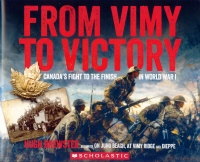| ________________
CM . . .
. Volume XXI Number 2. . . .September 12, 2014
excerpt:
From Vimy to Victory traces the history of the Canadian Corps in World War I from the start of the battle for Vimy Ridge on April 9, 1917 to the end of the war on November 11, 1918. It doesn’t flow like a usual history. Instead, it is the telling of a number of stories about people places and events of importance to the Canadian Corps. These give an accurate account of the experiences of Canadian soldiers. Readers learn, for example, about Private Tommy Holmes who captured 19 Germans after crawling through the mud and tossing two hand grenades into a pillbox. Readers also learn about Canon Frederick Scott who gave spiritual comfort to needy soldiers. There are no listed chapters, but every two or three pages deal with a specific aspect of the war. For example, there are “Doing Battle In A Sea Of Mud” and “A Town Called Wipers”. For much of the war, the battlefield was often mud, and “Wipers” was how Canadian soldiers pronounced Ypres. Besides the battle for Vimy, From Vimy to Victory covers other major battles, such as Ypres and Passchendaele. It also discusses Arthur Currie, the Canadian General who was put in charge of the Canadian Corps, the first time Canadian soldiers were commended by a Canadian. Up to then, they had been commanded by a British general since Canada was a part of the British Empire. There are also references to the heroics of brave soldiers who did extraordinary things. Okill Learmouth, cited in the above excerpt, is but one example. From Vimy to Victory has a glossary, an index and suggestions of “Recommended Reading” for both children and adults. It has many black and white illustrations and some in colour spread throughout the book. Most of the illustrations tell a story. In some cases, they are so dramatic that few words are needed as an explanation. There are also six very fine maps which help to locate and put the struggles of the Canadian soldiers in perspective. Hugh Brewster, the author of From Vimy to Victory has been involved in the publishing industry for many years, both as an editor and an award-winning author. He has previously written a number of war-related histories for young readers, including On Juno Beach and Dieppe. Recommended. Thomas F. Chambers, an author and retired college teacher, lives in North Bay, ON.
To comment
on this title or this review, send mail to cm@umanitoba.ca.
Copyright © the Manitoba Library Association. Reproduction for personal
use is permitted only if this copyright notice is maintained. Any
other reproduction is prohibited without permission.
Next Review |
Table of Contents for This Issue
- September 12, 2014. |
